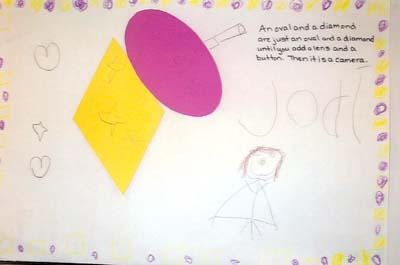

Name: Holly Urbina
Grade Level: Kindergarten
Teacher Materials Needed: The Shape of Things by Dayle Ann Dodds, 1 sheet of 11x17 white paper for each student, and approximately 10 each of the following shapes cut from various colors of construction paper: square, circle, triangle, diamond, oval, and rectangle.
Student Materials Needed: crayons, glue sticks
My Mathematical Goals for This Lesson: To increase student awareness of simple geometric shapes and their presence in their environment. To increase student understanding of patterns.
Related NC Standard Course of Study Goals/Objectives:
2.01 Recognize basic two-dimensional (plane) figures: circle, square, triangle, and rectangle. Describe their likenesses and differences and identify them in the environment.
3.03 Identify, copy, continue, and describe patterns.
Launch: Introduce the book by saying, "The book we are going to read today is called The Shape of Things. What do you think this book might be about? What do you notice about the cover? Does it give you any clues?" After the students share their ideas, show them the inside cover and facing page, filled with colorful shapes. Ask the students, "What do you notice about these pages?" They may comment on the patterns. If they do, have them to read one of the patterns aloud. When they come to the end of the pattern, ask them what they think would come next in the pattern and why.
Read the book to the students. After reading the book, turn back and ask the students to look carefully at some of the pages. Ask, "What are some of the things you noticed about the pictures and the words in this book?" Be sure that they understand the concept of taking a shape and making something with it.
Ask, "If we wanted to make our own pictures like the ones in this book, what would we need to do? What sorts of things are included on each page?" As the children are offering suggestions, flip through the book and let them see examples. If the children do not point it out, be sure that they are aware of the following:
Each page has its own shape.
Each shape makes part of a picture.
The words for each page start the same way.
Every page has a border of shapes.
The border of each page is a repeating pattern.
Explore: Explain to the class that everyone is going to make their own picture like the ones in the book. Have them to tell you once again what they would put on their page. Tell them to think about what they might make with shapes. Allow each student to choose two shapes, when they choose the shapes, ask them to identify the shape and color. Instruct the class to glue their shapes to their large sheet of paper and then, using their crayons, make a picture with their shapes. Remind them that they may want to put a border around their page. Display the open book as a reference.
Circulate and observe students as they work. If some students are having difficulty, ask other students to help them come up with ideas. Go to each student as they complete their pictures and ask them to tell you what shapes they chose to use, what they added to the shapes, and what they made with the shapes and the added parts. Narrate their pictures for them in the same pattern the book used. (A _______ and a _______ are just a _______ and a ______. Until you add ______, ________, and ______. Then they are _______.)
Summarize: Ask students to identify some shapes they see in the classroom. Ask if they can find any patterns in the classroom.
Assessment/Evidence of Learning: The conversation while reading sharing the book and while making their pictures will be an informal assessment, as will their completed pictures. Ask yourself, "Did the student identify the shapes correctly. Did he/she understand and follow the directions? Was the student able to produce a patterned border for his/her picture?"



